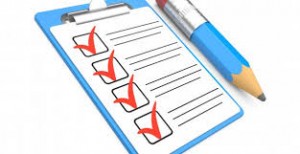It is midway through March and that means you have likely drafted some teams, or you still have time to prepare for Fantasy Baseball Drafts, or as I like to put it "Prepping for the Prep." Whether you are an established owner in one or more leagues, brand spanking new to the game, or are …
7 Steps to a Successful Fantasy Baseball Draft Strategy

It is midway through March and that means you have likely drafted some teams, or you still have time to prepare for Fantasy Baseball Drafts, or as I like to put it “Prepping for the Prep.” Whether you are an established owner in one or more leagues, brand spanking new to the game, or are testing the waters of a new format (Auction/Dynasty Leagues) preparation in some capacity should happen prior to your Fantasy Draft. How much you study or prepare is completely up to you.
Over the upcoming weeks, I will help guide you through your preparation round by round and based on what pick you have in the draft, while also trying to encompass most formats.
Disclaimer: Auction leagues are a completely different beast, so check this post on 25 Dos and Don’ts of Auction Strategies out by Gonos. I will primarily focus on Redraft/Dynasty formats.
So, if you are new to Fantasy Baseball, or even if you’re not, you may be feeling overwhelmed. You may be concerned about not knowing all of the players, when to pick certain positions, or concerned you will not be able hold back your adoration for your favorite local team player and reach for him in the drafts. That’s where draft tools come in to play.
Many owners will simply buy a “Fantasy Guide” (use code “gonos14” to save $1) of their choosing, highlighting a few players, and utilizing the top 300 enclosed. Others will solely use the draft site rankings.
Can this work? Sure. However, you need to be aware there is more you can do, and having a draft strategy is critical to continued success.
So what do you need to do to prepare for prepping in your leagues, you ask? Let me help you prep for the Draft Prep.
1. Know Your League(s) Rules and Scoring
This is the most critical step of all in my opinion. Many Re-Draft leagues (YAHOO, ESPN) have a standard format by default for Head-to-head leagues, Points leagues or Rotisserie. 5×5 categories typically make up standard scoring (R, RBI, HR, Steal, AVG./W, Ks, ERA, SV, WHIP). It is YOUR job to know and understand your roster requirements, as well as the scoring. Having the League rules and understanding them are both very important, and instrumental to developing an overall strategy. Study the scoring and understand it. If you are new to the game ask questions, or make sure you are using the right rankings and guides for your prep.
If you are in a 2-Catcher league, corner- or middle-infielder league, you need to make sure you are accounting for this in you draft prep. You don’t want to purchase a Fantasy guide or site subscription that isn’t aimed at your leagues format, or fails to consider categories your league may use when it plays a major role in your team makeup. You also need to make sure your top 300 is aimed at, or close to, your league’s settings.
An example of why this is important: I was in a points league for the first time a few years ago. I replaced an owner who dropped at the last minute, so I drafted that very night. I wanted some cheap power, so I took Mark Reynolds, a near lock for 35-plus Home Runs and 90 RBI. The problem with this pick? It was a points league which gave negative points for strikeouts. Reynolds lost me almost 200 points just in strikeouts alone. It was a terrible pick, and made it hard for me to even start him.
Bottom line: Know your league rules, understand them and if possible make note of them on your Draft Day cheat sheet, spreadsheet, fantasy guide, or whatever you should use in the heat of draft battle. Sound overwhelming? Well, it kind of is, but if you put the work in, you will likely have an upper hand on other owners, who may not do the same. Especially in start-up leagues.
More and more leagues are using categories like Quality Starts, OPS, or K/9. Be sure you don’t overlook this and plan accordingly.
2. Fantasy Baseball Draft Strategy: Understanding League Format
Is it an Auction league? A Keeper League? A Dynasty League? A Standard re-draft league? “What kind of league is it?” Unless you are a complete rookie to Fantasy Baseball this is one of the first questions commonly asked prior to joining. Make sure you know the format and adjust your draft preparations accordingly.
In a Dynasty League the will to win now should still dominate your strategy, BUT you also need to consider the future. Drafting a seasoned veteran here or there, or in the first 10 rounds is fine, but if you draft too many you may end up with a one-year wonder, or worse.
The same goes the other way, if you draft too young, you may never achieve the success you need to win by constantly searching for the young prospects. Find the happy medium. If you are passing on a player like Adrian Beltre for a younger third basemen like Nick Castellanos, he had better be solid, or the rest of your team needs to make up for the likely deficit at the position the first few years.
3. Make Your Own Cheat Sheet
This one is pretty simple. Study your league rules/scoring and roster requirements, and make your own cheat sheet to utilize during the draft. A top 300 alone just won’t cut it, because it won’t account for when to draft your third outfielder, or your middle infielder.
Live draft rooms are helpful as they typically show who was drafted, your current roster, and allow you to build a queue of players to target. They are not perfect, however, and most site rankings are all over the map.
What if you are at a friend’s place during a live draft and your wireless connection drops? Having a typed up or hand-written sheet can be a life saver. Technology can be amazing, while also making things smooth and easy for you in your prep/draft.
However, it can also backfire.
I have been in a few drafts where another owner showed up with just their iPad only to have the battery die, or the draft room/rankings,/league site not load properly. That quickly becomes their darkest hour, as I end up watching them scramble to borrow another owners’ Fantasy Guide, or look over someone’s shoulder to see the draft board. This is both humorous, and painful to watch. So, as I said previously, HAVE A BACKUP PLAN to your draft tools.
I typically make a spreadsheet, keep it simple, or make it as complex as you want. You can simply do players and rounds projected (Utilizing ADP), or bolster it with last year’s stats, projections, points, etc. (I like to do this)
If you’re in a Dynasty league, consider adding the players’ ages. Auction leagues add dollar value, or perhaps an estimated balance ledger.
Use as many tools as you want, but your cheat sheet is your best weapon. If you want check out mine and use it, feel free Draft Day Cheatsheet. Make it your own adding more columns, stats and scoring/roster settings.
Player A, B, and C should be obvious. It’s your top three choices in each round. I typically get these based on ADP and rankings. Sites such as Mockdraftcentral.com , Fantasypros.com, or my personal favorite, using the NFBC ADP.
So, if you have the fourth pick in Round 1 and pick 21 in Round 2, you will want to focus on targeting guys in the ADP of 17-24 range for Round 2. Be realistic. Listing players who are going at pick 14/15 on average shouldn’t be on your sheet for pick 21. It doesn’t mean if they are there you don’t take them, but just save time and be realistic. Don’t be that owner who shouts “NO! That was my pick,” and then take an extra 10 minutes or more to scramble and search for another guy.
4. Using Rankings and ADP
I typically utilize multiple sets of rankings, and combine with ADP on some of the fantasy sites. In fact, you can find my positional rankings on davidgonos.com, as well as fantasypros.com, along with several other fantastic industry experts. Feel free to check them out. If you don’t trust mine alone (which is fine, of course) use almost 35 other writers’ rankings. This can help you gauge an average ranking on certain players.
Utilizing ADP can help tie it all together by looking at a ranking and then the Average Draft Position of said player. Let’s just say you see Jason Kipnis ranked 33rd overall. Can you plan on him being available in the third round? Perhaps, but if his ADP is 25th and you really want him, plan accordingly. Most importantly have a Plan B and C, in case Kipnis is taken.
You can do a free one-man mock draft here, to get a better idea of where certain players should be targeted.
I encourage using multiple sets of rankings and consolidate them if it makes it easier, (this takes time of course, but can be well worth it for studying purposes (or simply use Fantasypros.com’s consensus rankings).
There are also sites that can create rankings/customize for you based on your league parameters. They are rarely free, but can assist in doing all of the grunt work for you if you are interested in going that route.
5. Utilize Tiers!
If you know me well, or have gotten in a Fantasy argument with me before, you will know I am a HUGE tier guy. I love them, I don’t live strictly by them, but for the most part I use them in every Fantasy Sport and every draft.
I plan on creating tiers for each position that you can use for your own draft planning over the next few weeks at DavidGonos.com. Or you can likely find some on the Interwebs and simply print them out, etc.
Why do tiers work? It can help by breaking down positions, by player potential and ceiling. So if you are torn between a Second Baseman or Shortstop, and there is a Tier-2 Second Baseman available, or a Tier-3 Shortstop, it can make your decision significantly easier. Of course, your existing roster, and positional scarcity all need to be considered as well.
So, if you don’t have either position, you may take the top-tiered shortstop because of more positional depth at second base.
It’s always up to you, but remember, tiers will shrink a position into chunks and if used effectively will help you dominate your draft.
6. Know Your Fellow Leaguemates
If you are joining a new league with new people, this is harder to do. If you are a returning member, though, you likely already have a feel for your league and its owners. You know there is the guy who LOVES pitchers, or the guy who will load up on the two best power hitters early, or the guy who loves his rookies and prospects.
Perhaps there is even the big drinker who by the later rounds of the draft is so drunk, he is slurring out Pedro Florimon for his Middle-Infield position.
Knowing these owners and their Draft Day or Fantasy season tendencies can give you an edge. If you know a guy may reach for his favorite player in a certain round, or snag another pitcher in the upcoming round, you can plan around that.
In auction drafts, you may need to spend more on a key player you need if you know another owner will likely target them. If you play like to play with fire, why not raise the bid price. If a guy is hellbent on landing Jedd Gyorko (like me), make him pay absolute top dollar. Just don’t poison yourself!
During the season you can also gauge how much FAAB to bid, when to put in claims on backups, or when rookies start seeing more playing time. None of this is critical, but it can all help you throughout your fantasy draft and season.
7. Keep an Eye on Positional Battles and Injuries
Knowing who is next in line, or competing for a starting spot can be a huge weapon on Draft Day. That poor hapless owner with his top-300 ranking list from a Fantasy guide printed in December, could very well be oblivious that his next target, listed as a starter is hurt, or now sharing play-time with a rookie.
Keeping tabs on this is time consuming, but can be made a bit easier utilizing web sites such as PROPLAYERSTATUS.COM, Twitter, or even your league’s own home page.
Cutting You Loose
After reading up on my seven steps to Fantasy Baseball draft strategy success, I think you are all ready to start studying now and getting your cheatsheets ready. Hop to it, and check out my other piece focusing on Rounds 1-3 of your Fantasy Baseball drafts, found here: Fantasy Baseball Draft Strategy: Part 1.









